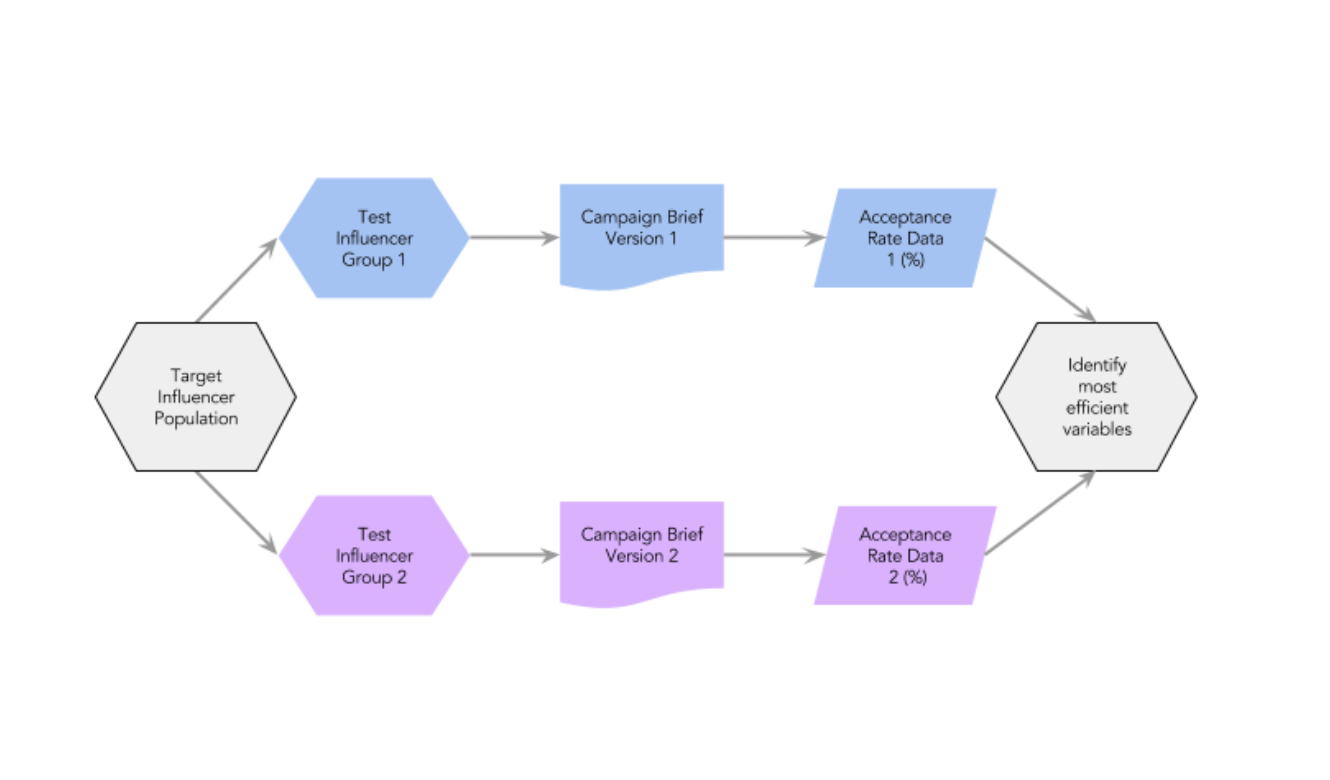Table of Contents
- Stellar Influencer Campaigns Series
Stellar Influencer Campaigns Series
In our last part of our trilogy guide on influencer marketing, we show how to drive velocity in your campaigns.
Using Campaign Acceptance Rate to Craft an Effective Recruitment Strategy
Once the team managing the campaign must identify target influencers (and how many are required). They proceed to create a concise brief (influencer facing overview document) summarizing:
- Brand involved
- Context of the products or services they will feature
- Key messaging and easy to follow instructions
- Compensation
- Campaign participation expectations
Once your influencer marketing campaign starts, the campaign brief should initially take a sample group of your total targeted influencer population. Test for effectiveness by measuring the Campaign Acceptance Rate (the frequency influencers are opting-in to your campaign).
- Campaign Acceptance Rate: The actual number of influencers who agreed (or provided a campaign participation affirmation) to participate in a brand campaign divided by the total number of influencers contacted to participate in a brand campaign. This metric is key to predicting anticipated influencer campaign participation.
- Campaign Acceptance Rates should be as close to 100% as possible. However, industry norms range from 10% to 80% plus depending.
- The higher your campaign acceptance rate, the more efficient your recruitment efforts will become. Meaning it will require less time to find, vet, and communicate with influencers during the initial stages of a campaign.
- High acceptance rates typically mean users are engaged in a particular campaign. This can also be a sign that operational efforts down the line, such as contract negotiation or content submission management, will be more efficient, as influencers may be more willing to participate. This isn’t always the case, though.
Split Testing the Influencer Variable Efficiency Identification Process


By testing different recruitment approaches for the highest acceptance rates, influencer marketers can improve campaign recruitment strategy by controlling specific variables that affect influencer recruitment success over time.
Using Single Submission Success Rate to Drive Efficiency in Content Submission Processes
Most active influencer campaigns need marketing teams to manage some type of content creation process between the brand and the creators who are crafting the content.
Once an influencer accepts the campaign brief, management teams begin gathering content, reminding influencers about content creation guidelines, submitting posts for approval from key stakeholders, and ensuring posts that are going live are satisfying brand requirements.
The overall operational efficiency of the content creation and submission processes can be measured for effectiveness by calculating what is called the influencer Single Submission Success Rate. This metric is the frequency of influencers who are submitting content that meets requirement guidelines with no additional updates, edit, or changes throughout a campaign.
- Influencer Single Submission Success Rate: Total number of influencers whose initial content submission required no additional updates, edits, or changes divided by the total number of influencers who submitted content.
- Single Submission Success Rates will vary from campaign to campaign. It should be as close to 100% as possible, as this is a positive indicator that the content being created for a campaign follows brand messaging, specific campaign instructions, and is meeting ongoing creative media requirements.
- The higher your Single Submission Success Rate is, the more efficient your influencer content creation will become. You’ll spend less time tracking content resubmissions, corresponding with influencers, or waiting for creative content to be recreated (aka turnaround on content changes). All of these issues increase fulfillment labor hours and impact a team’s ability to scale campaigns.
- Campaign management teams can use Single Submission Success Rate to increase operational efficiency by adjusting (or split testing) variables associated with content creation requirements, campaign brief instructions, content submission processes, or communications between teams and influencers.
Typically when campaign brief instructions are too long, complex, or vague, teams end up spending a lot of time going back and forth with influencers to create the desired piece of content their brand or client is looking for.
The more effective campaign content creation processes are, the more likely influencers will craft media that’s in accordance with the desired requirements. Measuring the performance of operational tasks associated with influencer content production will allow teams to better understand where they stand, and how they can improve.
Dynamically Determining Influencer Campaign Timelines
Most influencer marketers have some type of timeline they must keep. Often times, conditions such as seasonality, periodical budget requirements, or other coinciding advertising promotions create schedules that marketers are required to adhere to in order to meet their brand’s or client’s demands.
Ad creative and placement will always have a human element. Since every influencer marketing campaign behaves differently, accurately predicting a campaign’s timeline is challenging, but not impossible.
To predict the completion time remaining for a campaign, the managing marketing team should perform the following three steps throughout the duration of a campaign:
- Before starting a campaign, define the number of influencers required to participate in a campaign
- Record how many operational labor hours it takes to complete the content creation processes
- Use Influencer Acceptance and Single Submission Success rates to calculate the total labor hours remaining
Step 1: Defining the Number of Required Influencers
Marketers should start off by defining a success KPI (key performance indicator) in a measurable format.
The team managing the campaign should then find out how many influencers will be required to participate in a campaign to complete a specific brand objective. This number can be based on KPIs such as total CPM, CPE, CPA, or desired pieces of user-generated content. The brand can also simply disclose the number of influencers they want taking part in a campaign as part of their requirements.
For example, if a campaign’s target KPI requires 500,000 impressions, and the brand only wants to work with influencers who can reach at least 10,000 impressions each per post, then the team can determine they will need to activate 50 influencers to complete the campaign.
It’s important that managers know the exact number of remaining influencer activations required to complete a campaign throughout the operational fulfillment process. Think of this step as a countdown as each post is approved and goes live until there are no more remaining influencers required to activate.
Step 2: Recording Operational Labor Hours Required to Complete the Content Creation Process
Throughout the duration of a campaign, it’s important that teams determine, as accurately as possible, how many labor hours are required to complete each task in recruiting and managing the content creation process.
One of the best ways to do this is to start a timer and track how much time is required to complete each task associated with influencer correspondence, content creation processes, and post-approval. This can be easily done with an iPhone, Chrome Extension, or free task management solution like KanbanFlow.
Knowing the exact amount of time that’s required to complete each part of your unique fulfillment workflow is key to calculating how many labor hours you have left to complete a campaign. For each person working on the campaign, times should be tracked, averaged, and then segmented by each step of the fulfillment process (typically tasks are segmented by recruitment, content creation, and post-approval stages).
Step 3: Use Influencer Acceptance and Single Submission Success Rates to Determine Remaining Time Requirements
Once the marketing team understands how many activated influencers are remaining and how long it takes on average to complete each fulfillment task in influencer recruitment, content creation, and post-approval, they are ready to move on to the last step of calculating the total remaining labor hours required to complete their campaign.
By combining the following calculations, teams can use the previously determined Influencer Acceptance and Single Submission Success Rates to figure out their campaign specific remaining labor hour estimation requirements to campaign completion (see the steps and formulas below):
1. Calculate how many labor hours it will take to contact and recruit the remaining influencers for your campaign.
2. Calculate how many labor hours it will take to manage the content creation processes with your selected remaining influencers.
3. Sum all the labor hours remaining to complete the campaign and predict the number of days required to fulfill operational objectives.
We hope our entire Stellar Influencer Campaign Series helped bring a new, more thoughtful approach to influencer marketing campaigns.
Questions? Comment below, or message us on Facebook! We’re here to help.
Plus, you can always drop us line directly on our website as well 🙂




























